Lifetime and Fluorescence Quantum Yield of Two Fluorescein-Amino Acid-Based Compounds in Different Organic Solvents and Gold Colloidal Suspensions
Abstract
:1. Introduction
2. Materials and Methods
3. Results and Discussion
4. Conclusions
Supplementary Materials
Author Contributions
Acknowledgments
Conflicts of Interest
References
- Burchak, O.N.; Mugherli, L.; Chatelain, F.; Balakirev, M.Y. Fluorescein-Based Amino Acids for Solid Phase Synthesis of Fluorogenic Protease Substrates. Bioorg. Med. Chem. 2006, 14, 2559–2568. [Google Scholar] [CrossRef] [PubMed]
- Oliveira, E.; Bértolo, E.; Núñez, C.; Pilla, V.; Santos, H.M.; Fernández-Lodeiro, J.; Fernández-Lodeiro, A.; Djafari, J.; Capelo, J.L.; Lodeiro, C. Green and Red Fluorescent Dyes for Translational Applications in Imaging and Sensing Analytes: A Dual-Color Flag. ChemistryOpen 2018, 7, 9–52. [Google Scholar] [CrossRef] [PubMed]
- Xiong, X.; Song, F.; Wang, J.; Zhang, Y.; Xue, Y.; Sun, L.; Jiang, N.; Gao, P.; Tian, L.; Peng, X. Thermally Activated Delayed Fluorescence of Fluorescein Derivative for Time-Resolved and Confocal Fluorescence Imaging. J. Am. Chem. Soc. 2014, 136, 9590–9597. [Google Scholar] [CrossRef] [PubMed]
- Zheng, H.; Zhan, X.Q.; Bian, Q.N.; Zhang, X.J. Advances in Modifying Fluorescein and Rhodamine Fluorophores as Fluorescent Chemosensors. Chem. Commun. 2013, 49, 429–447. [Google Scholar] [CrossRef] [PubMed]
- Sjöback, R.; Nygren, J.; Kubista, M. Absorption and Fluorescence Properties of Fluorescein. Spectrochim. Acta A 1995, 51, L7–L21. [Google Scholar] [CrossRef]
- Zhang, X.F.; Zhang, J.; Liu, L. Fluorescence Properties of Twenty Fluorescein Derivatives: Lifetime, Quantum Yield, Absorption and Emission Spectra. J. Fluoresc. 2014, 24, 819–826. [Google Scholar] [CrossRef] [PubMed]
- Barba-Bom, A.; Costero, A.M.; Gil, S.; Parra, M.; Soto, J.; Martínez-Máñez, R.; Sancenón, F. A New Selective Fluorogenic Probe for Trivalent Cations. Chem. Commun. 2012, 48, 3000–3002. [Google Scholar] [CrossRef] [PubMed]
- Song, A.; Zhang, J.; Zhang, M.; Shen, T.; Tang, J. Spectral Properties and Structure of Fluorescein and its Alkyl Derivatives in Micelles. Colloids Surf. A Physicochem. Eng. Asp. 2000, 167, 253–262. [Google Scholar] [CrossRef]
- Martin, M.M.; Lindqvist, L. The pH Dependence of Fluorescein Fluorescence. J. Lumin. 1975, 10, 381–390. [Google Scholar] [CrossRef]
- Martin, E.; Pardo, A.; Guijarro, M.S.; Fernandez-Alonso, J.I. Photophysics Properties of Fluorescein in Alcoholic Medium for Different pH. J. Mol. Struct. 1986, 142, 197–200. [Google Scholar] [CrossRef]
- Zhao, Z.G.; Shen, T.; Xu, H.J. The Absorption and Structure of Fluorescein and its Ethyl Derivatives in Various Solutions. Spectrochim. Acta A 1989, 45, 1113–1116. [Google Scholar] [CrossRef]
- Song, A.; Wu, T.; Chen, S.; Zhang, M.; Shen, T. Syntheses and Photophysical Properties of Amphiphilic Dyads of Fluorescein and Carbazole Linked with a Flexible or Semi-rigid Bridge. Dyes Pigments 1998, 39, 371–382. [Google Scholar] [CrossRef]
- Martin, M.M. Hydrogen Bond Effects on Radiationless Electronic Transitions in Xanthene Dyes. Chem. Phys. Lett. 1975, 35, 105–111. [Google Scholar] [CrossRef]
- Klonis, N.; Clayton, A.H.A.; Voss, E.W., Jr.; Sawyer, W.H. Spectral Properties of Fluorescein in Solvent-Water Mixtures: Applications as a Probe of Hydrogen Bonding Environments in Biological Systems. Photochem. Photobiol. 1998, 67, 500–510. [Google Scholar] [CrossRef] [PubMed]
- Mchedlov-Petrossyan, N.O.; Ivanov, V.V. Effect of the Solvent on the Absorption Spectra and Protonation of Fluorescein Dye Anions. Russ. J. Phys. Chem. A 2007, 81, 112–115. [Google Scholar] [CrossRef]
- Homocianu, M.; Airinei, A.; Dorohoi, D.O. Solvent Effects on the Electronic Absorption and Fluorescence Spectra. J. Adv. Res. Phys. 2017, 2, 011105. Available online: http://stoner.phys.uaic.ro/jarp/index.php?journal=jarp&page=article&op=view&path%5B%5D=30 (accessed on 8 May 2018).
- Magde, D.; Rojas, G.E.; Seybold, P.G. Solvent Dependence of the Fluorescence Lifetimes of Xanthene Dyes. Photochem. Photobiol. 1999, 70, 737–744. [Google Scholar] [CrossRef]
- Gidwani, M.S.; Menon, S.K.; Agrawal, Y.K. Fluorescence and Lasing Characteristics of Fluorescein Calix[4]aryl Hydroxamic Acid. Indian J. Chem. Technol. 2003, 10, 519–524. Available online: http://nopr.niscair.res.in/handle/123456789/22786 (accessed on 8 May 2018).
- Bindhu, C.V.; Harilal, S.S.; Nampoori, V.P.N.; Vallabhan, C.P.G. Solvent Effect on Absolute Fluorescence Quantum Yield of Rhodamine 6G Determined Using Transient Thermal Lens Technique. Mod. Phys. Lett. B 1999, 13, 563–576. [Google Scholar] [CrossRef]
- Sinha, S.; Ray, A.; Dasgupta, K. Solvent Dependent Nonlinear Refraction in Organic Dye Solution. J. Appl. Phys. 2000, 87, 3222–3226. [Google Scholar] [CrossRef]
- Magde, D.; Wong, R.; Seybold, P.G. Fluorescence Quantum Yields and Their Relation to Lifetimes of Rhodamine 6G and Fluorescein in Nine Solvents: Improved Absolute Standards for Quantum Yields. Photochem. Photobiol. 2002, 75, 327–334. [Google Scholar] [CrossRef]
- Gonçalves, A.C.; Pilla, V.; Oliveira, E.; Santos, S.M.; Capelo, J.L.; Dos Santos, A.A.; Lodeiro, C. The Interaction of Hg2+ and Trivalent Ions with Two New Fluorescein Bio-inspired Dual Colorimetric/Fluorimetric Probes. Dalton Trans. 2016, 45, 9513–9522. [Google Scholar] [CrossRef] [PubMed]
- Akshath, U.S.; Bhatt, P. Gold Nanoparticle Synthesis Coupled to Fluorescence Turn-on for Sensitive Detection of Formaldehyde using Formaldehyde Dehydrogenase. RSC Adv. 2016, 6, 54777–54784. [Google Scholar] [CrossRef]
- Yang, G.; Xiang, S.; Zhang, K.; Gao, D.; Zeng, C.; Zhao, F. Breast Cancer Imaging with Fluoresce in Isothiocyanate-Modified Gold Nanoparticles In-Vidro and In-Vivo. Int. J. Clin. Exp. Med. 2016, 9, 753–759. Available online: http://www.ijcem.com/V9_No2.html (accessed on 8 May 2018).
- Tao, H.; Liao, X.; Xu, M.; Xie, X.; Zhong, F.; Yi, Z. Detection of Immunoglobulin G based on Nanoparticle Surface Energy Transfers from Fluorescein Isothiocyanate to Gold Nanoparticles. Anal. Methods 2014, 6, 2560–2565. [Google Scholar] [CrossRef]
- Barnoy, E.A.; Fixler, D.; Popovtzer, R.; Nayhoz, T.; Ray, K. An Ultra-Sensitive Dual-Mode Imaging System Using Metal-Enhanced Fluorescence in Solid Phantoms. Nano Res. 2015, 8, 3912–3921. [Google Scholar] [CrossRef] [PubMed]
- Chen, C.; Zhao, D.; Sun, J.; Yang, X. A Dual-Mode Signaling Response of a AuNP-Fluorescein Based Probe for Specific Detection of Thiourea. Analyst 2016, 141, 2581–2587. [Google Scholar] [CrossRef] [PubMed]
- Sironi, L.; Freddi, S.; D’Alfonso, L.; Collini, M.; Gorletta, T.; Soddu, S.; Chirico, G. p53 Detection by Fluorescence Lifetime on a Hybrid Fluorescein Isothiocyanate Gold Nanosensor. J. Biomed. Nanotechnol. 2009, 5, 683–691. [Google Scholar] [CrossRef] [PubMed]
- Yu, K.K.; Li, K.; Qin, H.H.; Zhou, Q.; Qian, C.H.; Liu, Y.H.; Yu, X.Q. Construction of pH-Sensitive “Submarine” Based on Gold Nanoparticles with Double Insurance for Intracellular pH Mapping, Quantifying of Whole Cells and in Vivo Applications. ACS Appl. Mater. Interfaces 2016, 8, 22839–22848. [Google Scholar] [CrossRef] [PubMed]
- Fernández-Lodeiro, J.; Núñez, C.; Oliveira, E.; Capelo, J.L.; Lodeiro, C. 1D Chain Fluorescein-Functionalized Gold and Silver Nanoparticles as New Optical Mercury Chemosensor in Aqueous Media. J. Nanopart. Res. 2013, 15, 1828. [Google Scholar] [CrossRef]
- Hoop, M.; Mushtaq, F.; Hurter, C.; Chen, X.Z.; Nelson, B.J.; Pané, S. A Smart Multifunctional Drug Delivery Nanoplatform for Targeting Cancer Cells. Nanoscale 2016, 8, 12723–12728. [Google Scholar] [CrossRef] [PubMed]
- Fernández-Lodeiro, J.; Rodríguez-González, B.; Santos, H.M.; Bértolo, E.; Capelo, J.L.; Dos Santos, A.A.; Lodeiro, C. Unraveling the Organotellurium Chemistry Applied to the Synthesis of Gold Nanomaterials. ACS Omega 2016, 1, 1314–1325. [Google Scholar] [CrossRef]
- Montalti, M.; Credi, A.; Prodi, L.; Gandolfi, M.T. Handbook of Photochemistry, 3rd ed.; Taylor & Francis: Boca Raton, FL, USA, 2006; ISBN 9780824723774. [Google Scholar]
- Wypych, G. Handbook of Solvents; ChemTec Publishing and William Andrew Inc.: Toronto, ON, Canada; New York, NY, USA, 2001; ISBN 1-895198-24-0. [Google Scholar]
- Mata, R.A.; Costa Cabral, B.J. Structural, Energetic, and Electronic Properties of (CH3CN)2-8 Clusters by Density Functional Theory. J. Mol. Struct. (THEOCHEM) 2004, 673, 155–164. [Google Scholar] [CrossRef]
- Aaron, J.J.; Maafi, M.; Párkányi, C.; Boniface, C. Quantitative Treatment of the Solvent Effects on the Electronic Absorption and Fluorescence Spectra of Acridines and Phenazines. The Ground and First Excited Singlet-State Dipole Moments. Spectrochim. Acta 1995, 51, 603–615. [Google Scholar] [CrossRef]
- Ali, M.; Dutta, P.; Pandey, S. Effect of Ionic Liquid on Prototropic and Solvatochromic Behavior of Fluorescein. J. Phys. Chem. B 2010, 114, 15042–15051. [Google Scholar] [CrossRef] [PubMed]
- Al-Tememee, N.A.A.; Al-Ani, S.K.J.; AbdAlfahdaw, A.A. Effect of Solvents on the Dipole Moments and Fluorescence Quantum Yield of Rhodamine Dyes. ISESCO J. Sci. Technol. 2013, 9, 34–42. Available online: https://www.isesco.org.ma/ISESCO_Technology_Vision/NUM16/doc/5.pdf (accessed on 8 May 2018).
- Alvarez-Pez, J.M.; Ballesteros, L.; Talavera, E.; Yguerabide, J. Fluorescein Excited-State Proton Exchange Reactions: Nanosecond Emission Kinetics and Correlation with Steady-State Fluorescence Intensity. J. Phys. Chem. A 2001, 105, 6320–6332. [Google Scholar] [CrossRef] [Green Version]
- Ueno, T.; Urano, Y.; Setsukinai, K.; Takakusa, H.; Kojima, H.; Kikuchi, K.; Ohkubo, K.; Fukuzumi, S.; Nagano, T. Rational Principles for Modulating Fluorescence Properties of Fluorescein. J. Am. Chem. Soc. 2004, 126, 14079–14085. [Google Scholar] [CrossRef] [PubMed]
- Strickler, S.J.; Berg, R.A. Relationship Between Absorption Intensity and Fluorescence Lifetime of Molecules. J. Chem. Phys. 1962, 37, 814–822. [Google Scholar] [CrossRef]
- Zhang, X.F. The Effect of Phenyl Substitution on the Fluorescence Characteristics of Fluorescein Derivatives via Intramolecular Photoinduced Electron Transfer. Photochem. Photobiol. Sci. 2010, 9, 1261–1268. [Google Scholar] [CrossRef] [PubMed]
- Tamulis, A.; Tamuliene, J.; Balevicius, M.L.; Rinkevicius, Z.; Tamulis, V. Quantum Mechanical Studies of Intensity in Electronic Spectra of Fluorescein Dianion and Monoanion Forms. Struct. Chem. 2003, 14, 643–648. [Google Scholar] [CrossRef]
- Batistela, V.R.; da Costa Cedran, J.; de Oliveira, H.P.M.; Scarminio, I.S.; Ueno, L.T.; da Hora Machado, A.E.; Hioka, N. Protolytic Fluorescein Species Evaluated Using Chemometry and DFT Studies. Dyes Pigments 2010, 86, 15–24. [Google Scholar] [CrossRef]
- Togashi, D.M.; Szczupak, B.; Ryder, A.G.; Calvet, A.; O’Loughlin, M. Investigating Tryptophan Quenching of Fluorescein Fluorescence under Protolytic Equilibrium. J. Phys. Chem. A 2009, 113, 2757–2767. [Google Scholar] [CrossRef] [PubMed] [Green Version]
- Boens, N.; Qin, W.; Basarić, N.; Hofkens, J.; Ameloot, M.; Pouget, J.; Lefèvre, J.P.; Valeur, B.; Gratton, E.; VandeVen, M.; et al. Fluorescence Lifetime Standards for Time and Frequency Domain Fluorescence Spectroscopy. Anal. Chem. 2007, 79, 2137–2149. [Google Scholar] [CrossRef] [PubMed] [Green Version]
- Fernández-Lodeiro, J.; Nuñez, C.; Fernández-Lodeiro, A.; Oliveira, E.; Rodríguez-González, B.; Dos Santos, A.A.; Capelo, J.L.; Lodeiro, C. New-coated Fluorescent Silver Nanoparticles with a Fluorescein Thiol Esther Derivative: Fluorescent Enhancement upon Interaction with Heavy Metal Ions. J. Nanopart. Res. 2014, 16, 2315. [Google Scholar] [CrossRef]
- Kumar, A.; De, A.; Saxena, A.; Mozumdar, S. Environmentally Benign Synthesis of Positively Charged, Ultra-Low Sized Colloidal Gold in Universal Solvent. Adv. Nat. Sci. Nanosci. Nanotechnol. 2014, 5, 025017. [Google Scholar] [CrossRef]
- Lu, G.W.; Gao, P. Handbook of Non-Invasive Drug Delivery Systems; Emulsions and Microemulsions for Topical and Transdermal Drug Delivery, 1st ed.; William Andrew: Norwich, NY, USA, 2010; pp. 59–94. ISBN 9780815520252. [Google Scholar]
- Guo, J.; Armstrong, M.J.; O’Driscoll, C.M.; Holmes, J.D.; Rahme, K. Positively Charged, Surfactant-Free Gold Nanoparticles for Nuclei Acid Delivery. RSC Adv. 2015, 5, 17862–17871. [Google Scholar] [CrossRef]
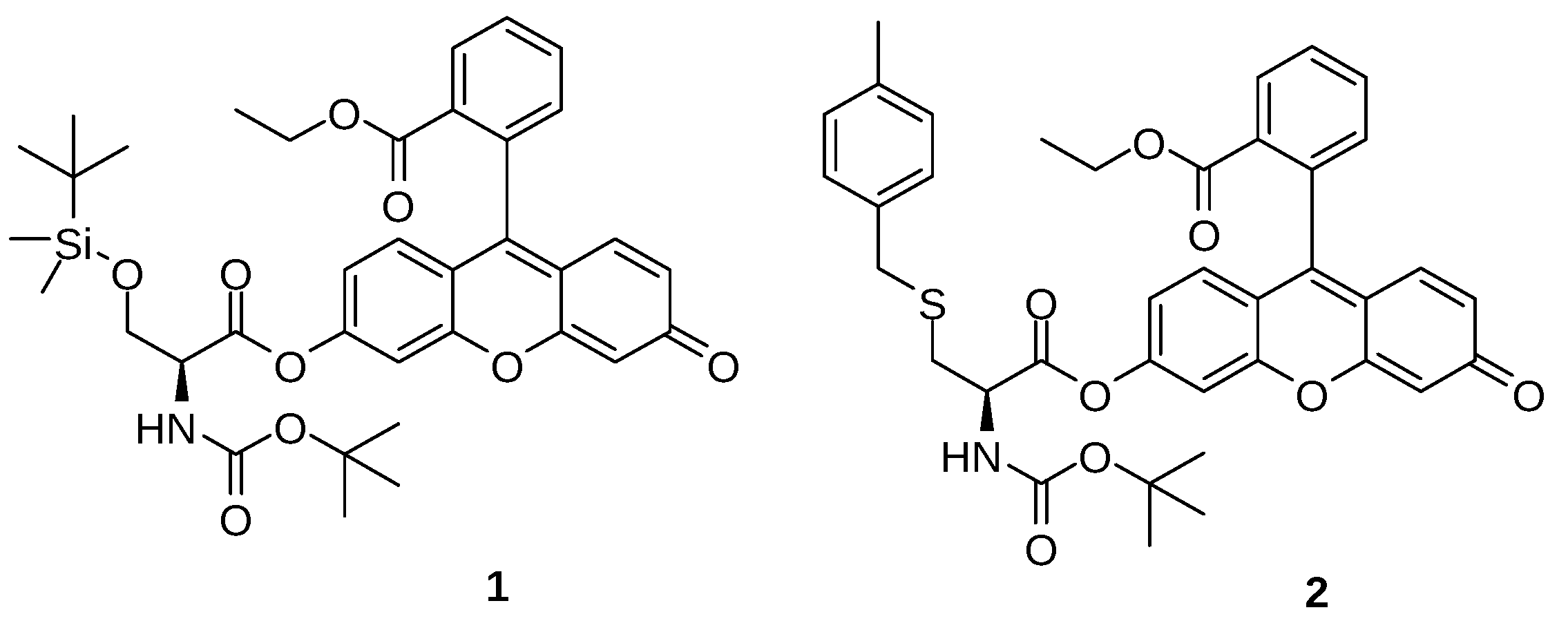
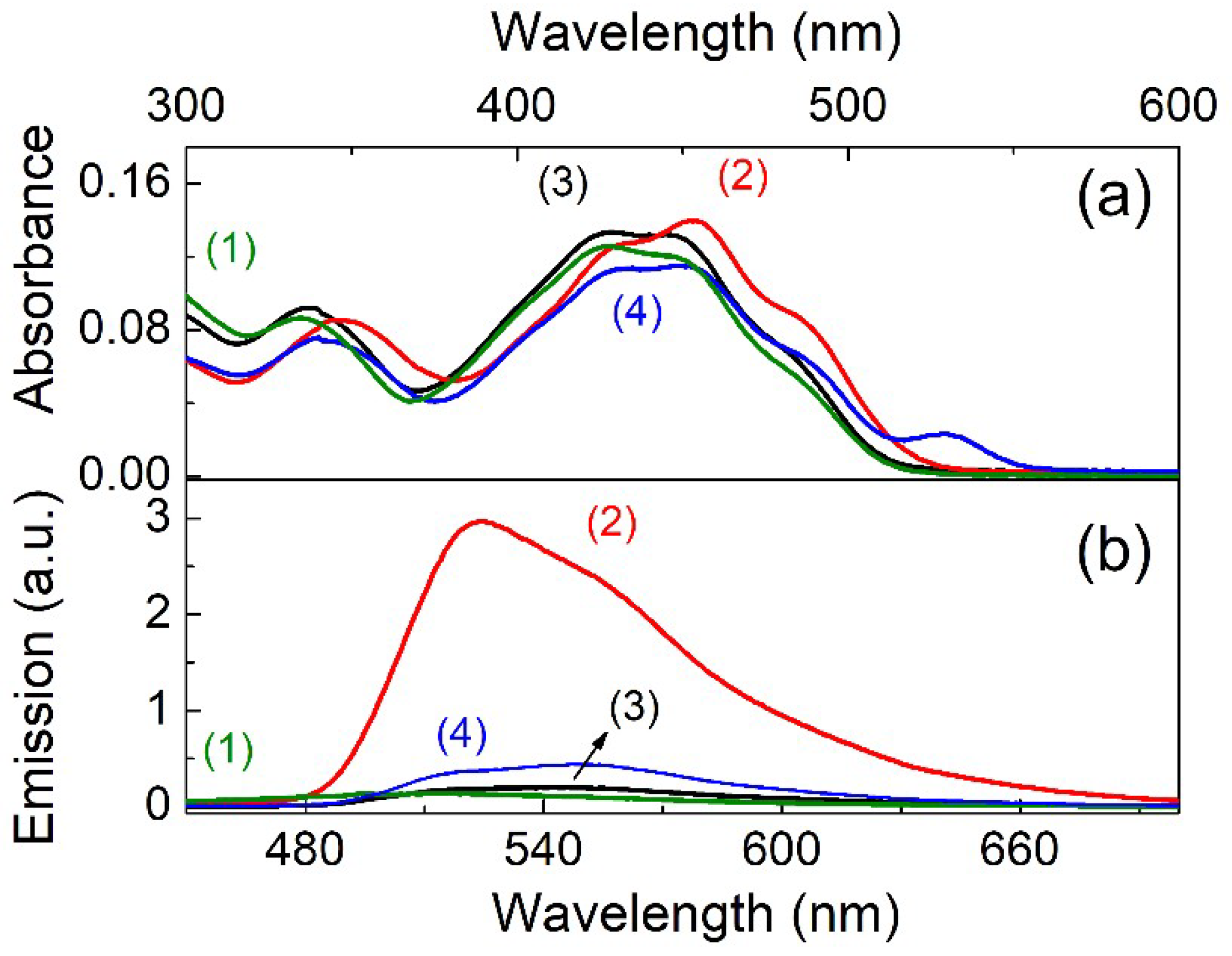
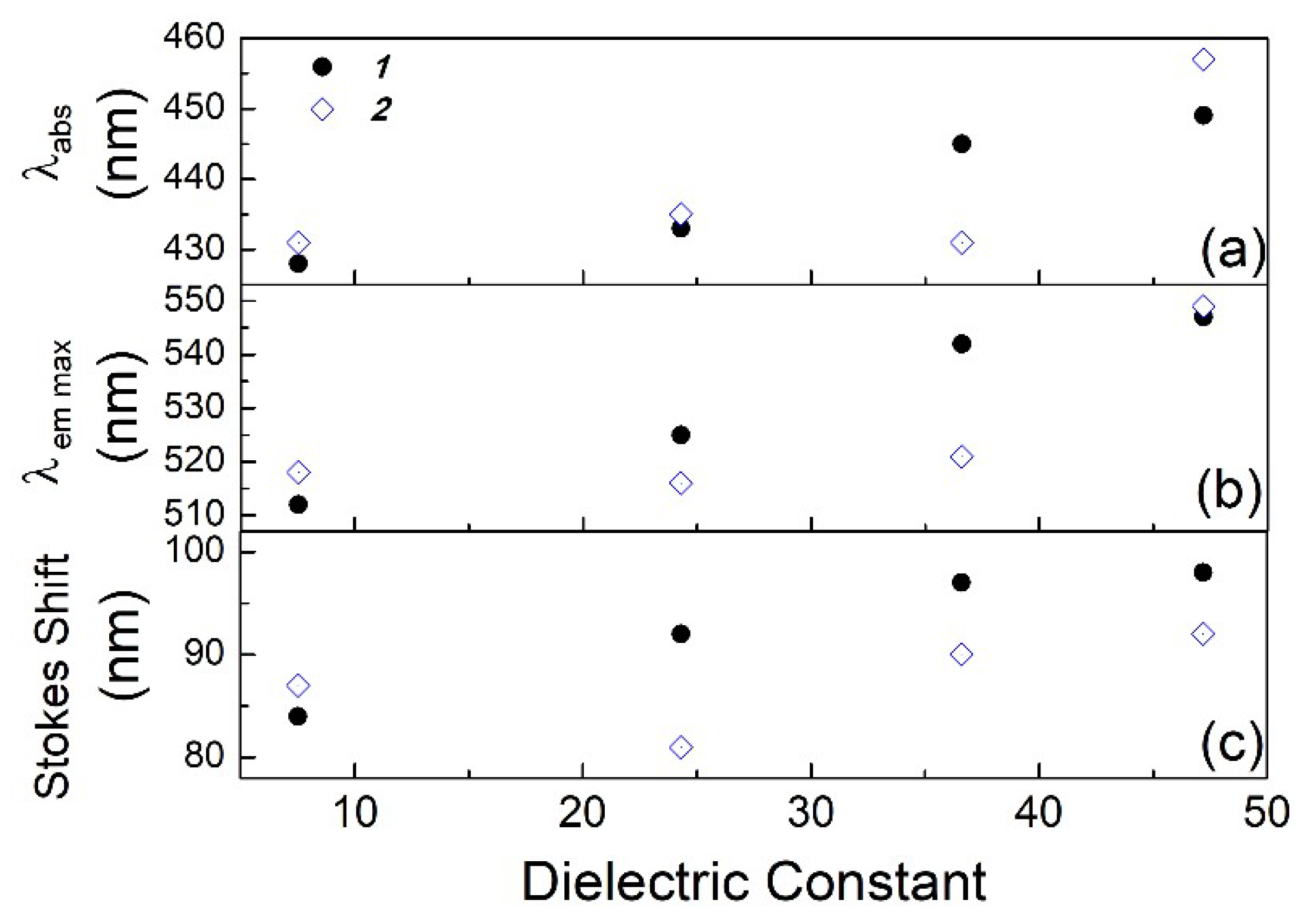

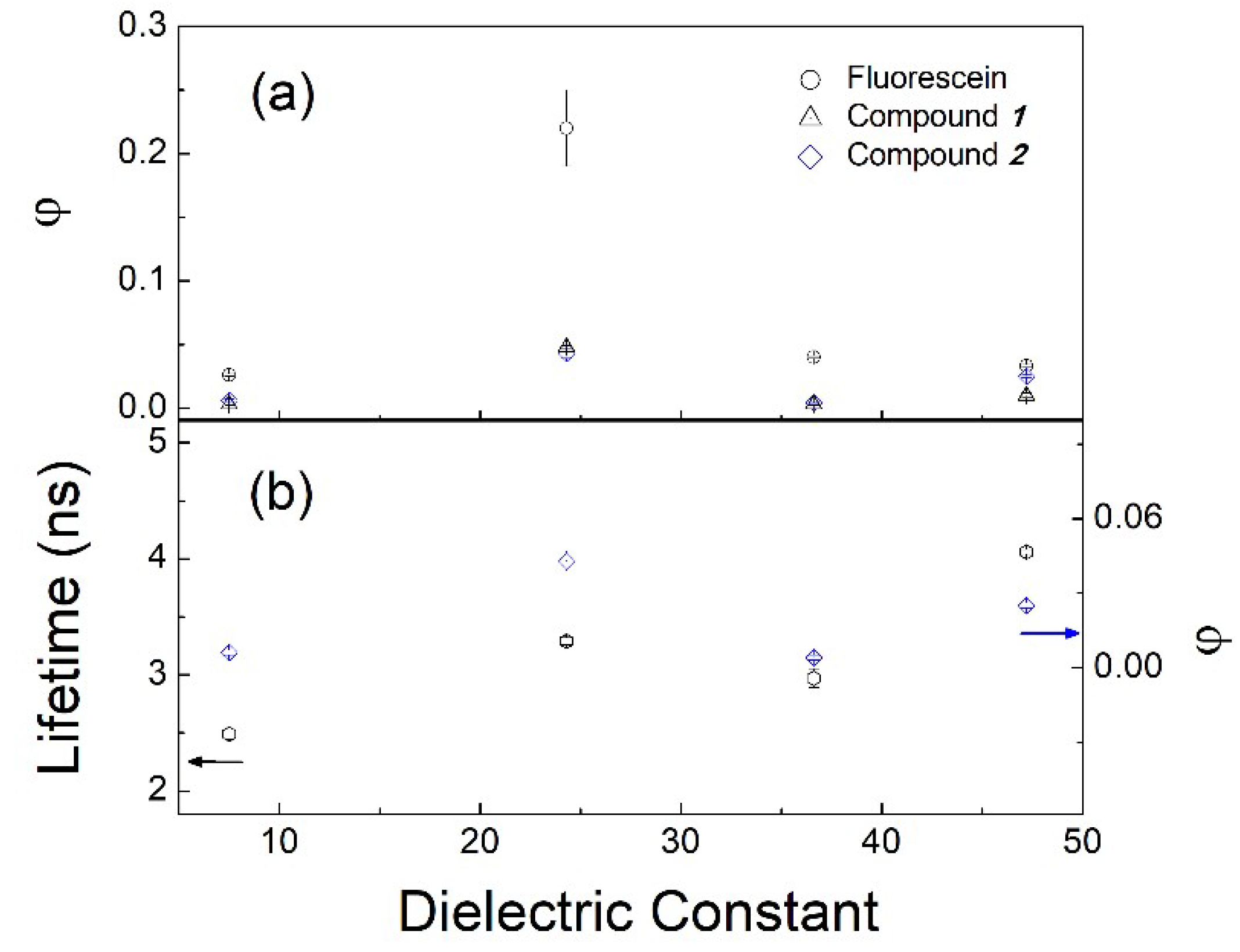
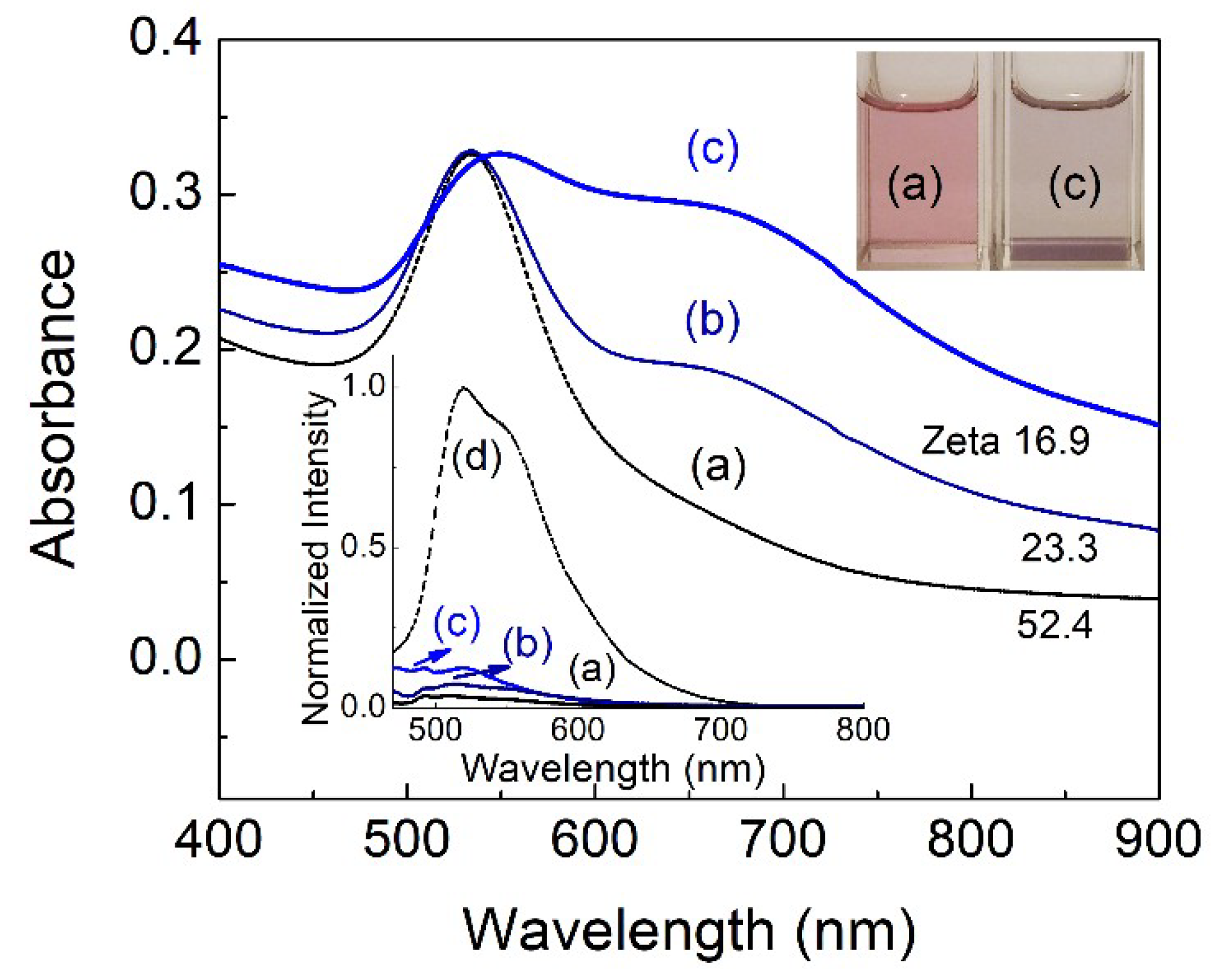
| Solvent | UV–vis λabs (nm) | Log ε | Fluorescence λem max (nm) | Stokes shift (nm) | Quantum Yield φ | Lifetime τ1 (ns) | Dielectric Constant (εr) | |
|---|---|---|---|---|---|---|---|---|
| 1 | THF | 428 | 4.10 | 512 | 84 | 0.003 | 2.3 ± 0.2 | 7.52 |
| Ethanol | 433 | 4.10 | 525 | 92 | 0.048 | 3.65 ± 0.02 | 24.3 | |
| Acetonitrile | 445 | 4.12 | 542 | 97 | 0.003 | 2.7 ± 0.1 | 36.6 | |
| DMSO | 449 | 4.06 | 547 | 98 | 0.010 | 4.03 ± 0.02 | 47.2 | |
| 2 | THF | 431 | 4.01 | 518 | 87 | 0.006 | 2.49 ± 0.05 | 7.52 |
| Ethanol | 435 | 3.89 | 516 | 81 | 0.043 | 3.29 ± 0.03 | 24.3 | |
| Acetonitrile | 431 | 4.01 | 521 | 90 | 0.004 | 2.97 ± 0.08 | 36.6 | |
| DMSO | 457 | 4.04 | 549 | 92 | 0.025 | 4.06 ± 0.02 | 47.2 |
| Compound 1 | Compound 2 | |||||
|---|---|---|---|---|---|---|
| τ1 (ns) | τ2 (ns) | χ2 | τ1 (ns) | τ2 (ns) | χ2 | |
| B1 (Rel. Amp.%) | B2 (Rel. Amp.%) | B1 (Rel. Amp.%) | B2 (Rel. Amp.%) | |||
| THF | 2.3 ± 0.2 | 0.08 ± 0.02 | 0.98 ± 0.09 | 2.49 ± 0.05 | 0.110 ± 0.005 | 1.01 ± 0.09 |
| (C4H8O) | 1.9 | 98.1 | 3.3 | 96.7 | ||
| Ethanol | 3.65 ± 0.02 | 0.788 ± 0.009 | 1.01 ± 0.04 | 3.29 ± 0.03 | 0.90 ± 0.06 | 1.1 ± 0.1 |
| (C2H6O) | 40 | 60 | 93 | 7 | ||
| Acetonitrile | 2.70 ± 0.06 | 0.231 ± 0.006 | 1.03 ± 0.08 | 2.97 ± 0.08 | 0.357 ± 0.003 | 1.0 ± 0.1 |
| (CH3CN) | 5.6 | 94.4 | 6 | 94 | ||
| DMSO | 4.03 ± 0.02 | 0.13 ± 0.08 | 1.09 ± 0.07 | 4.06 ± 0.02 | 0.65 ± 0.02 | 1.02 ± 0.07 |
| ((CH3)2SO) | 79 | 21 | 48 | 52 | ||
© 2018 by the authors. Licensee MDPI, Basel, Switzerland. This article is an open access article distributed under the terms and conditions of the Creative Commons Attribution (CC BY) license (http://creativecommons.org/licenses/by/4.0/).
Share and Cite
Pilla, V.; Gonçalves, A.C.; Dos Santos, A.A.; Lodeiro, C. Lifetime and Fluorescence Quantum Yield of Two Fluorescein-Amino Acid-Based Compounds in Different Organic Solvents and Gold Colloidal Suspensions. Chemosensors 2018, 6, 26. https://doi.org/10.3390/chemosensors6030026
Pilla V, Gonçalves AC, Dos Santos AA, Lodeiro C. Lifetime and Fluorescence Quantum Yield of Two Fluorescein-Amino Acid-Based Compounds in Different Organic Solvents and Gold Colloidal Suspensions. Chemosensors. 2018; 6(3):26. https://doi.org/10.3390/chemosensors6030026
Chicago/Turabian StylePilla, Viviane, Augusto C. Gonçalves, Alcindo A. Dos Santos, and Carlos Lodeiro. 2018. "Lifetime and Fluorescence Quantum Yield of Two Fluorescein-Amino Acid-Based Compounds in Different Organic Solvents and Gold Colloidal Suspensions" Chemosensors 6, no. 3: 26. https://doi.org/10.3390/chemosensors6030026






